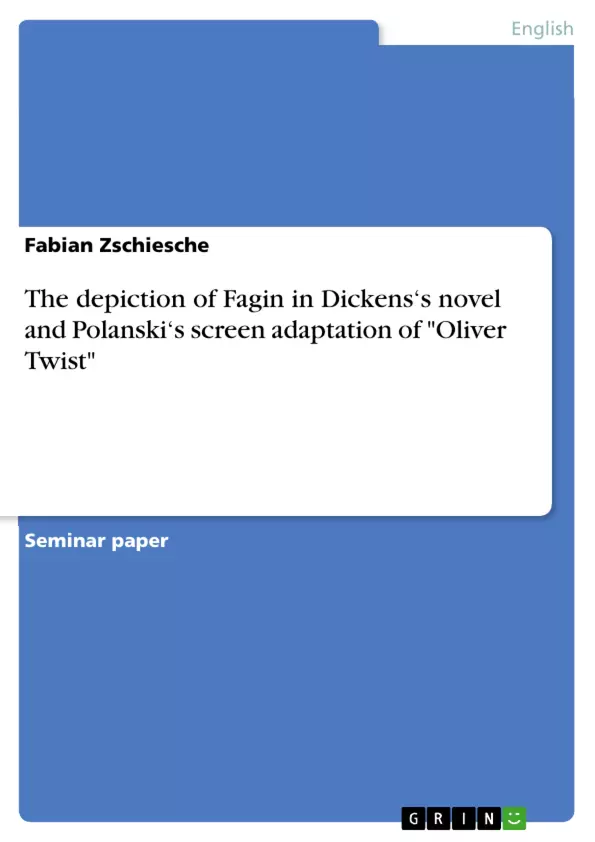"Who is Fagin?" is not only a question one might come across when reading Charles Dickens’s "Oliver Twist" or watching one of its screen adaptations. In fact, this question has so far concerned different literary critics all approaching various aspects from his role as the "Jew" (Paganoni, Steyn, Morse), over the question whether he is actually villainous or not, to debates concerning gender issues (Foley) and therefore asking if he fulfils either a maternal or paternal role for the children of his gang. Without a doubt there is probably no other character in Charles Dickens‘s novel that offers so many points of critique and or possible interpretations. Although the main plot of the story is about Oliver Twist, it is Fagin who‘s depiction in the novel and later on screen adaptations gets most of the attention by reviews and discussions.
Consequently in my term paper I will mainly deal with Fagin in Charles Dickens’s "Oliver Twist" and will focus on the way Fagin is depicted. Before going into detail on several very distinctive issues, I will analyse his behaviour, language and appearance in general throughout the novel. One of those distinctive issues is his special role for the children as he could be regarded not only as a villain figure but to a certain extent also as some caring paternal or maternal figure. Moreover the question about Fagin‘s depiction as the Jew will be taken care of in a very detailed way since this had been a extremely polarising issue throughout the ages.
Since several of those aspect also come up in Ben Kingsley’s interpretation of his role as Fagin in Roman Polanski’s film version of the novel, I will also analyse whether Polanski’s Fagin is a ‘realistic’ adaptation of the character Dickens portrays in his novel or whether Polanski and Kingsley create their own Fagin and to what extent Polanski‘s adaptation shows similarities with and differences to the novel. Nevertheless I will mainly focus on Dickens’s Fagin and his importance for the story of Oliver.
Table of Contents
- Introduction
- The depiction of Charles Dickens's Fagin
- Appearance, language and behaviour
- Fagin and the conflict of gender roles
- Fagin as a Jew - Race and prejudices
- Fagin as a threat to the Anglo-Christian Victorian family values
- Polanski's screen adaptation of Oliver Twist
- Polanski´s and Kingsley's interpretation of Fagin
- Differences and similarities between the film and the novel
- Similarities
- Differences
Objectives and Key Themes
This term paper analyzes the depiction of Fagin in Charles Dickens's novel Oliver Twist and its screen adaptation by Roman Polanski, exploring the character's role as a villain, a caring paternal figure, and a representation of Jewish stereotypes. The paper examines Fagin's appearance, language, and behaviour in the novel, as well as the ways in which he is interpreted by Polanski and actor Ben Kingsley in the film adaptation.
- The depiction of Fagin in Charles Dickens's Oliver Twist
- Fagin's role as a villain and a potential paternal figure
- The portrayal of Fagin as a Jewish stereotype and the associated prejudices
- Analysis of Polanski's film adaptation and its differences and similarities to the novel
- The role of gender in Fagin's characterization
Chapter Summaries
The introduction explores the complex and multifaceted character of Fagin, highlighting his controversial depiction as a villain, a potential father figure, and a Jewish stereotype. The paper introduces the main themes and objectives of the study, which focuses on the portrayal of Fagin in both the novel and the film adaptation. The first chapter delves into the depiction of Fagin in Charles Dickens's Oliver Twist, analyzing his appearance, language, and behavior. The chapter explores Fagin's ambiguous nature, his shifting personality, and the complex relationship he has with Oliver Twist and other characters. The second chapter examines the issue of gender roles in Fagin's characterization, exploring whether he displays maternal or paternal attributes. The chapter challenges traditional notions of gender roles and their impact on the interpretation of Fagin's character. The third chapter analyzes the portrayal of Fagin as a Jewish stereotype in Dickens's novel, focusing on the racial prejudices and stereotypes that contribute to his depiction. The chapter discusses the historical context of antisemitism and its influence on the representation of Jewish characters in literature. The fourth chapter examines Fagin's role as a threat to the Anglo-Christian Victorian family values, analyzing how his character embodies the anxieties and fears of the Victorian society. The chapter explores the ways in which Fagin's depiction reinforces societal norms and expectations. The fifth chapter delves into Roman Polanski's film adaptation of Oliver Twist, exploring the director's and actor Ben Kingsley's interpretation of Fagin. The chapter examines the similarities and differences between the film and the novel, analyzing how Polanski adapts the character and his portrayal in the movie.
Keywords
Key topics and terms explored in this paper include the depiction of Fagin, Charles Dickens, Oliver Twist, Roman Polanski, Ben Kingsley, film adaptation, villain, paternal figure, Jewish stereotypes, gender roles, antisemitism, Victorian family values, and cultural anxieties.
- Quote paper
- Fabian Zschiesche (Author), 2012, The depiction of Fagin in Dickens‘s novel and Polanski‘s screen adaptation of "Oliver Twist", Munich, GRIN Verlag, https://www.grin.com/document/368122



